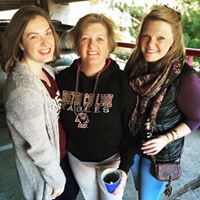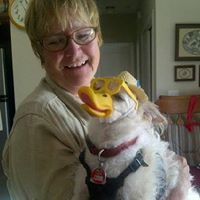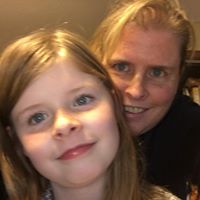Kathleen Dore Boyce
age ~80
from Shelburne, VT
- Also known as:
-
- Kathleen Dore Dr Boyce
- Kathleen D Boyce
- Kathleen Living Dore
- Boyce D Kathleen
- Phone and address:
-
183 Stonegate Ln, Shelburne, VT 05482
(541)9418024
Kathleen Boyce Phones & Addresses
- 183 Stonegate Ln, Shelburne, VT 05482 • (541)9418024
- Seaford, DE
- San Francisco, CA
- 101 Orange Ave, Ashland, OR 97520 • (541)4882647
- 785 Altos Oaks Dr, Los Altos, CA 94024 • (650)9492997
- 4 Main St, Los Altos Hills, CA 94022 • (650)9492997
- Sunnyvale, CA
Us Patents
-
Variable Volume Between Flexible Structure And Support Surface
view source -
US Patent:20060131163, Jun 22, 2006
-
Filed:Dec 16, 2004
-
Appl. No.:11/014490
-
Inventors:Ping Mei - Palo Alto CA, US
Jurgen Daniel - Mountain View CA, US
James Boyce - Los Altos CA, US
Kathleen Boyce - Ashland OR, US
Jackson Ho - Palo Alto CA, US
Rachel Lau - San Jose CA, US
Yu Wang - Union City CA, US -
International Classification:C25D 21/12
-
US Classification:204228800, 204228900, 204230700
-
Abstract:Cells can include variable volumes defined between a flexible structure, such as a polymer layer, and a support surface, with the flexible structure and support surface being attached in a first region that surrounds a second region in which they are unattached. Various adhesion structures can attach the flexible structure and the support surface. When unstretched, the flexible structure can lie in a flat position on the support surface. In response to a stretching force away from the support surface, the flexible structure can move out of the flat position, providing the variable volume. Electrodes, such as on the flexible structure, on the support surface, and over the flexible structure, can have charge levels that couple with each other and with the variable volume. A support structure can include a device layer with signal circuitry that provides a signal path between an electrode and external circuitry. One or more ducts can provide fluid communication with each cell's variable volume. Arrays of such cells can be implemented for various applications, such as optical modulators, displays, printheads, and microphones.
-
Systems And Methods For Biasing High Fill-Factor Sensor Arrays And The Like
view source -
US Patent:20060255422, Nov 16, 2006
-
Filed:Jul 25, 2006
-
Appl. No.:11/491998
-
Inventors:JengPing Lu - San Jose CA, US
James Boyce - Los Altos CA, US
Kathleen Boyce - Los Altos CA, US -
Assignee:PALO ALTO RESEARCH CENTER, INCORPORATED - Palo Alto CA
-
International Classification:H01L 31/00
-
US Classification:257458000
-
Abstract:A high fill-factor photosensor array is formed comprising a P-layer, an I-layer, one or more semiconductor structures adjacent to the I-layer and each coupled to a N-layer, an electrically conductive electrode formed on top of the P-layer, and an additional semiconductor structure, adjacent to the N-layer and which is electrically connected to a voltage bias source. The bias voltage applied to the additional semiconductor structure charges the additional semiconductor structure, thereby creating a tunneling effect between the N-layer and the P-layer, wherein electrons leave the N-layer and reach the P-layer and the electrically conductive layer. The electrons then migrate and distribute uniformly throughout the electrically conductive layer, which ensures a uniform bias voltage across to the entire photosensor array. The biasing scheme in the invention allows to achieve mass production of photosensors without the use of wire bonding.
-
Systems And Methods For Biasing High Fill-Factor Sensor Arrays And The Like
view source -
US Patent:20090160006, Jun 25, 2009
-
Filed:Feb 25, 2009
-
Appl. No.:12/379581
-
Inventors:JengPing Lu - San Jose CA, US
James B. Boyce - Los Altos CA, US
Kathleen Dore Boyce - Los Altos CA, US -
Assignee:Palo Alto Research Center, Inc. - Palo Alto CA
-
International Classification:H01L 31/105
H03K 3/01 -
US Classification:257458, 327534, 257E31061
-
Abstract:A high fill-factor photosensor array is formed comprising a P-layer, an I-layer, one or more semiconductor structures adjacent to the I-layer and each coupled to a N-layer, an electrically conductive electrode formed on top of the P-layer, and an additional semiconductor structure, adjacent to the N-layer and which is electrically connected to a voltage bias source. The bias voltage applied to the additional semiconductor structure charges the additional semiconductor structure, thereby creating a tunneling effect between the N-layer and the P-layer, wherein electrons leave the N-layer and reach the P-layer and the electrically conductive layer. The electrons then migrate and distribute uniformly throughout the electrically conductive layer, which ensures a uniform bias voltage across to the entire photosensor array. The biasing scheme in this invention allows to achieve mass production of photosensors without the use of wire bonding.
-
Systems And Methods For Biasing High Fill-Factor Sensor Arrays And The Like
view source -
US Patent:20090160007, Jun 25, 2009
-
Filed:Feb 25, 2009
-
Appl. No.:12/392943
-
Inventors:JengPing Lu - San Jose CA, US
James B. Boyce - Los Altos CA, US
Kathleen Dore Boyce - Los Altos CA, US -
Assignee:PALO ALTO RESEARCH CENTER, INC. - Palo Alto CA
-
International Classification:H01L 31/105
H01L 27/144 -
US Classification:257458, 257494, 257459, 257E29012, 257E31061
-
Abstract:A high fill-factor photosensor array is formed comprising a P-layer, an I-layer, one or more semiconductor structures adjacent to the I-layer and each coupled to a N-layer, an electrically conductive electrode formed on top of the P-layer, and an additional semiconductor structure, adjacent to the N-layer and which is electrically connected to a voltage bias source. The bias voltage applied to the additional semiconductor structure charges the additional semiconductor structure, thereby creating a tunneling effect between the N-layer and the P-layer, wherein electrons leave the N-layer and reach the P-layer and the electrically conductive layer. The electrons then migrate and distribute uniformly throughout the electrically conductive layer, which ensures a uniform bias voltage across to the entire photosensor array. The biasing scheme in this invention allows to achieve mass production of photosensors without the use of wire bonding.
-
Surface Micromachining Process Of Mems Ink Jet Drop Ejectors On Glass Substrates
view source -
US Patent:20110003405, Jan 6, 2011
-
Filed:Jul 1, 2009
-
Appl. No.:12/495827
-
Inventors:Chingwen Yeh - Cupertino CA, US
James B. Boyce - Los Altos CA, US
Kathleen Boyce - Shelburne VT, US
Jingkuang Chen - Rochester NY, US
Feixia Pan - Cypress CA, US
Joel A. Kubby - Rochester NY, US -
Assignee:XEROX CORPORATION - Norwalk CT
-
International Classification:H01L 21/30
-
US Classification:438 21, 257E21211
-
Abstract:Method and device for forming a membrane includes providing a glass substrate, and depositing a thin layer of chromium on the glass substrate. The thin layer of chromium is patterned to form a deflection electrode and interconnect leads. A sacrificial layer of aluminum is deposited on top of the patterned chromium layer, then the sacrificial layer is patterned to define anchor regions. On top of the sacrificial layer, a thick layer of chromium is deposited, and the thick layer of chromium is patterned to form a membrane. The sacrificial layer is then etched to release the membrane.
-
Systems And Methods For Biasing High Fill-Factor Sensor Arrays And The Like
view source -
US Patent:20050133813, Jun 23, 2005
-
Filed:Dec 22, 2003
-
Appl. No.:10/740466
-
Inventors:JengPing Lu - San Jose CA, US
James Boyce - Los Altos CA, US
Kathleen Boyce - Los Altos CA, US -
Assignee:PALO ALTO RESEARCH CENTER, INCORPORATED - PALO ALTO CA
-
International Classification:H01L029/74
-
US Classification:257119000
-
Abstract:A high fill-factor photosensor array is formed comprising a P-layer, an I-layer, one or more semiconductor structures adjacent to the I-layer and each coupled to a N-layer, an electrically conductive electrode formed on top of the P-layer, and an additional semiconductor structure, adjacent to the N-layer and which is electrically connected to a voltage bias source. The bias voltage applied to the additional semiconductor structure charges the additional semiconductor structure, thereby creating a tunneling effect between the N-layer and the P-layer, wherein electrons leave the N-layer and reach the P-layer and the electrically conductive layer. The electrons then migrate and distribute uniformly throughout the electrically conductive layer, which ensures a uniform bias voltage across to the entire photosensor array. The biasing scheme in this invention allows to achieve mass production of photosensors without the use of wire bonding.
Resumes

Kathleen Boyce
view source
Kathleen Boyce
view sourceLicense Records
Kathleen Ann Boyce
License #:
2000 - Expired
Category:
Nursing
Issued Date:
Jan 1, 1967
Effective Date:
Nov 1, 2011
Expiration Date:
Oct 31, 2011
Type:
Licensed Practical Nurse
Name / Title
Company / Classification
Phones & Addresses
Owner, Principal
Boyce Kathleen PH.D
Health Practitioner's Office
Health Practitioner's Office
4 Main St, Los Altos, CA 94022
Myspace
Flickr

Kathleen Boyce
view source
Kathleen Moulton Boyce
view source
Kathleen Boyce
view source
Kathleen Boyce Zannerini
view source
Kathleen Boyce
view source
Kathleen Golding Boyce
view source
Kathleen M Boyce
view source
Kathleen Young Boyce
view sourceClassmates

Kathleen Williams (Boyce)
view sourceSchools:
Immaculate Heart of Mary School Indianapolis IN 1979-1983
Community:
Dan Sadaka, Jeff Buntrock, John Mason, Jeanie Jana

Kathleen Boyce-rogers (Bo...
view sourceSchools:
Rome Catholic High School Rome NY 1964-1968
Community:
Jack May, Cary Berglund, Paulette Urbanski, Bruce Berglund, Nancy Schuessler

Kathleen Boyce (Jorgensen)
view sourceSchools:
Trail High School Trail Saudi Arabia 1977-1981
Community:
Audrey Gasser, Thomas Fillingham, Isabella Allan

Kathleen Boyce (Hall)
view sourceSchools:
Smoketown Elementary School Lancaster PA 1984-1990
Community:
Kelly Hemming, Sharon Burbank

Kathleen Boyce
view sourceSchools:
Clarke Elementary School Swampscott MA 1980-1984
Community:
Richard Torrey, David Kieser, Valerie Zirpolo, Paul Bollen, Derek Barr, Ted Chambers, Michael Delisio, Michael Fave, Allison Cobb, J Cohen, John Willis, Tara Cotton

Kathleen Kathleen Boyce ...
view sourceSchools:
St. Barnabas School Bellmore NY 1969-1975, Grand Avenue Middle School Bellmore NY 1975-1978
Community:
Kenneth Frachtman, Debra Phelps, Peter Mason

Kathleen Boyce (nee Mills...
view source
St. Martin of Tours Eleme...
view sourceGraduates:
Kathleen Boyce (1975-1979),
Anthony Portelli (1980-1984)
Anthony Portelli (1980-1984)
Googleplus

Kathleen Boyce

Kathleen Boyce
Youtube
Get Report for Kathleen Dore Boyce from Shelburne, VT, age ~80















